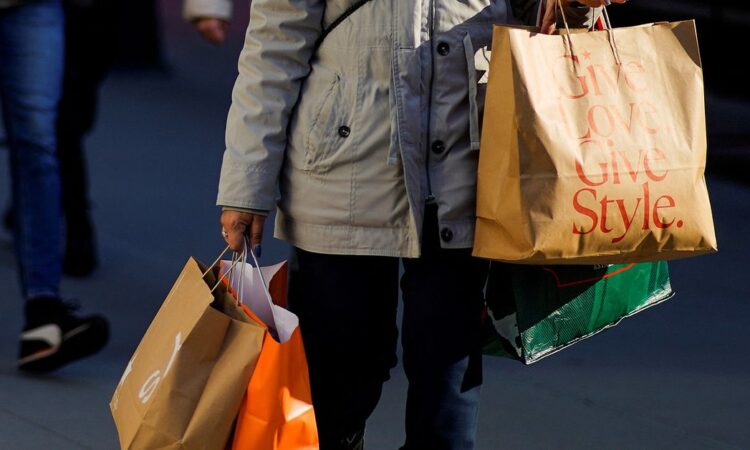
WASHINGTON, Feb 28 (Reuters) – U.S. consumer confidence unexpectedly fell in February, with the decrease concentrated among lower-middle-income households, though Americans grew more upbeat about the labor market.
The survey from the Conference Board on Tuesday also showed consumers apprehensive about buying big-ticket items like motor vehicles and household appliances over the next six months. But correlation between confidence and consumer spending has been weak. A strong labor market has kept Americans spending despite worries about the future fueled by the Federal Reserve’s stiff interest rate hikes to quell inflation.
“Households are likely cautious given inflation is still elevated and borrowing costs are rising,” said Rubeela Farooqi, chief U.S. economist at High Frequency Economics in White Plains, New York. “But they are continuing to spend for now, owing to strong job growth that is restoring incomes.”
The Conference Board’s consumer confidence index dropped to 102.9 this month from 106.0 in January. Economists polled by Reuters had forecast the index would be 108.5. The second straight monthly decline mostly reflected pessimism among consumers with annual incomes in the $35,000-$50,000 range.
Latest Updates
View 2 more stories
There were also decreases among other income groups, with the exception of the $25,000-$34,999 income bracket. Confidence dropped among consumers in the 35-54 age group.
Consumers expressed optimism about current economic conditions, but were becoming more fearful about the next six months. There is no consensus on whether the economy will experience a recession this year. Data on the labor market and consumer spending suggest the economy started 2023 on a strong note.
The broad decline in confidence is in stark contrast with the University of Michigan’s consumer sentiment index, which increased to a 14-month high in February.
“We are more inclined to take signals from the University of Michigan index, particularly on the path of consumer spending in the months ahead, as it has historically been a more-reliable indicator of future consumer spending trends,” said Colin Johanson, an economist at Barclays in New York.
Consumer spending increased by the most in nearly two years in January, driven by a surge in wage gains. Spending is likely to remain supported in the months ahead, with the Conference Board survey showing the share of consumers viewing jobs as “plentiful” rising back to levels seen in the spring of 2022.
As a result, the survey’s so-called labor market differential, derived from data on respondents’ views on whether jobs are plentiful or hard to get, rose to 41.5, the highest in nearly a year, from 37 in January. This measure correlates to the unemployment rate from the U.S. Labor Department. The 3.4% jobless rate in January was the lowest in more than 53 years.
Stocks on Wall Street were trading mixed. The dollar edged up against a basket of currencies. U.S. Treasury prices fell.
TIGHT LABOR MARKET
Labor market tightness and stubbornly high inflation have stoked fears that the Fed could continue raising interest rates into the summer. The U.S. central bank is expected to deliver two additional 25-basis-point rate hikes in March and May. Financial markets are betting on another increase in June. The Fed has raised its policy rate by 450 basis points since last March from the near-zero level to a 4.50%-4.75% range.
Consumers’ 12-month inflation expectations fell to 6.3% from 6.7% last month. With price pressures still strong, fewer consumers planned big-ticket purchases and travel over the next six months. They were also less enthusiastic about buying a home, especially with mortgage rates resuming their ascent.
Higher mortgage rates and home prices have pushed many potential buyers to the sidelines. There are, however, signs that housing affordability is starting to gradually improve.
The S&P CoreLogic Case-Shiller national home price index, covering all nine U.S. census divisions, increased 5.8% on a year-on-year basis in December, a separate report showed on Tuesday. That was the smallest annual gain since mid-2020 and followed a 7.6% rise in November. Prices increased 5.8% in 2022, pulling back from 2021’s record-setting 18.9% gain.
The slowdown was centered in the West, where annual house prices rose 1.2%. Prices fell in Francisco and Seattle, but rose moderately in Portland. Price growth remained strong in the South, with double-digit gains in Miami, Tampa and Atlanta.
Slowing overall house price inflation was corroborated by a report from the Federal Housing Finance Agency on Tuesday showing home prices advanced 6.6% in the 12 months through December, the smallest rise since June 2020, after increasing 8.2% in November. They increased 6.6% in 2022 compared to a gain of 18.0% in 2021.
“We expect home prices to remain under pressure this year but expect that a still-limited supply of homes for sale will cushion the downside,” said Nancy Vanden Houten, lead U.S. economist at Oxford Economics in New York.
A fourth report from the Commerce Department showed the goods trade deficit widened 2.0% to $91.5 billion in January, leaving trade on track to have little or no impact on GDP growth early in the first quarter.
A smaller trade deficit was one of the contributors to the economy’s 2.7% annualized growth pace in the fourth quarter. The other boost to growth came from inventories.
Wholesale inventories fell 0.4% last month after gaining 0.1% in December, the Commerce Department also showed. Stocks at retailers rose 0.3% after increasing 0.4% in December. Growth estimates for this quarter are as high as a 2.8% rate.
“The economy’s underlying trend is holding up and, if anything, modestly improving,” said Bill Adams, chief economist at Comerica Bank in Dallas. “The odds of a mediocre muddle-through economy in 2023 have increased over the last few months, while the odds of a more serious recession have receded.”
Reporting by Lucia Mutikani; Editing by Chizu Nomiyama, Andrea Ricci and Paul Simao
Our Standards: The Thomson Reuters Trust Principles.




